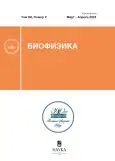Interrelation between Composition of Natural Water and a State of Lipid Peroxidation Processes in Biological Objects
- Authors: Shishkina L.N1, Dubovik A.S1, Shvydkyi V.O1, Kozlov M.V1, Shtamm E.V2, Georgiadi A.G3
-
Affiliations:
- N.M. Emanuel Institute of Biochemical Physics, Russian Academy of Sciences
- N.N. Semenov Federal Research Center for Chemical Physics, Russian Academy of Sciences
- Institute of Geography, Russian Academy of Sciences
- Issue: Vol 69, No 2 (2024)
- Pages: 341-348
- Section: Articles
- URL: https://journals.rcsi.science/0006-3029/article/view/257584
- DOI: https://doi.org/10.31857/S0006302924020161
- EDN: https://elibrary.ru/OTRCGX
- ID: 257584
Cite item
Full Text
Abstract
About the authors
L. N Shishkina
N.M. Emanuel Institute of Biochemical Physics, Russian Academy of Sciences
Email: shishkina@sky.chph.ras.ru
Moscow, Russia
A. S Dubovik
N.M. Emanuel Institute of Biochemical Physics, Russian Academy of SciencesMoscow, Russia
V. O Shvydkyi
N.M. Emanuel Institute of Biochemical Physics, Russian Academy of SciencesMoscow, Russia
M. V Kozlov
N.M. Emanuel Institute of Biochemical Physics, Russian Academy of SciencesMoscow, Russia
E. V Shtamm
N.N. Semenov Federal Research Center for Chemical Physics, Russian Academy of SciencesMoscow, Russia
A. G Georgiadi
Institute of Geography, Russian Academy of SciencesMoscow, Russia
References
- Eistnberg D. S. and Kauzmann W, Structure and Properties of Water.(Oxford University Press, New York, 1969).
- Зенин С. В. Исследование структуры воды метолом протонного магнитного резонанса. Докл. РАН. 332 (3), 328-329 (1993).
- Schindler T, Berg C.. Niedner-Schatterburg G., and Bondybey V. E. Reactions of water clusters H+(H2O)n= 3 -75, with diethyl e4ther. Chem. Phys. 201 (2–3), 491–496 (1995). doi: 10.1016/0301-0104(95)00288X
- Смирнов А. Н., Савин А. В. и Сигов А. С., Структурные превращения в жидкой воде. Биофизика, 65 (2), 408–411 (2020). DOI: 10/31867/ S0006302920010258
- Коновалов А. И. и Рыжкина И.С. Образование наноассоциатов – ключ к пониманию физико-химических и биологических свойств высокоразбавленных водных растворов. Изв. АН. Сер. химическая, № 1, 1–14 (2014).
- Konovalov A. I.. Mal’tseva E. L., Ryzkina I S., Murtazina L. I., Kiseleva Yu. V., Kasparov V. V., Pal’mina N. P. Formation of nanoassociates is a factor determining physicochemical and biological properties of highly diluted solutions. Dokl. Phys. Chem., 456 (2), 86–89 (2014). DOI: 10.1134/ S00125012516114060050
- Kononov L. Chemical tractivity and solution structure: on the way to a paradigm shift? RSC Adv., 5, 46718–46734 (2015).
- Росс. хим. журн., 58 (5) (1999). (Номер посвящен эффектам, закономерностям и механизмам действия биологически активных веществ в сверхмалых дозах и физических факторов низкой интенсивности.)
- Урнышева В. В. и Шишкина Л. Н. Влияние химических токсикантов в широком диапазоне концентраций на характеристики липидов эритроцитов крови мышей. Биофизика, 49 (3), 565–571 (2004).
- Zhernovkov V. E., Roshchina I. A., Zubareva G. M., Shmatov G. P., Lokshin B. N., and Pal’mina N. P. The study of thyrotropin-releasing hormone effect in a wide concentration range on the aquifer system by IR-spectroscopy method. Water, 27, 58–68 (2010).
- Belov V. V., Belyaeva I. A., Shmatov G. P., Zubareva G. M., and Pal’mina N. P. Dokl. Phys. Chem., 439 (1), 123–126 (2011). doi: 10.1134/S0012401611070013
- Chemical and Biological Kinetics. New Horizons. Vol. 2. Biological Kinetics. Ed. by E. B. Burlakova and S. D. Varfolomeev (VSP, Leden-Boston, 2005).
- Shtamm E. V., Shvydkiy V. O., Skurlatov Yu. I., and Semenyak L. V. Role of water-soluble compounds of reduced sulfur in the toxic properties of the aquatic environment. In: Antioxidants in systems of varying complexity. Chemical, biochemical and biological aspects. Ed. by L. N. Shishkina, A. N. Goloshchapov, and L. I. Weisfeld (AAP, Toromto, 2020), pp. 119–138.
- Кудяшева А. Г., Загорская Н. Г., Раскоша О. В. и Шишкина Л. Н. Регуляция окислительных процессов в органах мышей при действии химических и физических факторов в малых дозах. Биофизика, 66 (4), 741–749 (2021). doi: 10.31857/S0006302921040141
- Шишкина Л. Н., Козлов М. В., Повх А. Ю. и Швыдкий В.О. Роль перекисного окисления липидов в оценке последствий воздействия химических токсикантов на биообъекты. Хим. физика. 40 (9), 57–63 (2021). doi: 10.31857/S0207401X21090089
- Shvydkiy V., Dolgov S., Dubovik A., Kozlov M., Povkh A., Shishkina L., and Duca G. New Aspects for the Estimation of the State of the Natural Water. Chem. J. Moldova, 17 (2), 35–42 (2022). DOI: org/1019261/cjm.2022.973
- Биологические мембраны: методы. Под ред. Дж. Б. С. Финдлея и В. Х. Эванза (Мир, М., 1990).
- Шишкина Л. Н., Кушнирева Е. В. и Смотряева М. А. Новые подходы к оценке биоллгических последстви1 воздействия радиации в малых дозах. Радиац. биология. Радиоэкология. 44 (3), 289–295 (2004).
- Asakawa T. and Matsushita S. Coloring conditions of thiobarbituric acid test for detesting lipid hydroperoxides. Lipids, 15 (3), 137–140 (1980).
- Брин Э. Ф. и Травин С. О. Моделирование механизма химических реакций. Хим. физика, 10 (6), 830–837 (1991).
- Берия Л. В., Исмаилов А. Д. и Данилов В. С. Стимуляция биолюминесцентной активности бактериальной люциферазы продуктами Fe2+-индуцированного перекисного окисления липидов. Биохимия, 56 (3), 477–485 (1991).
Supplementary files










